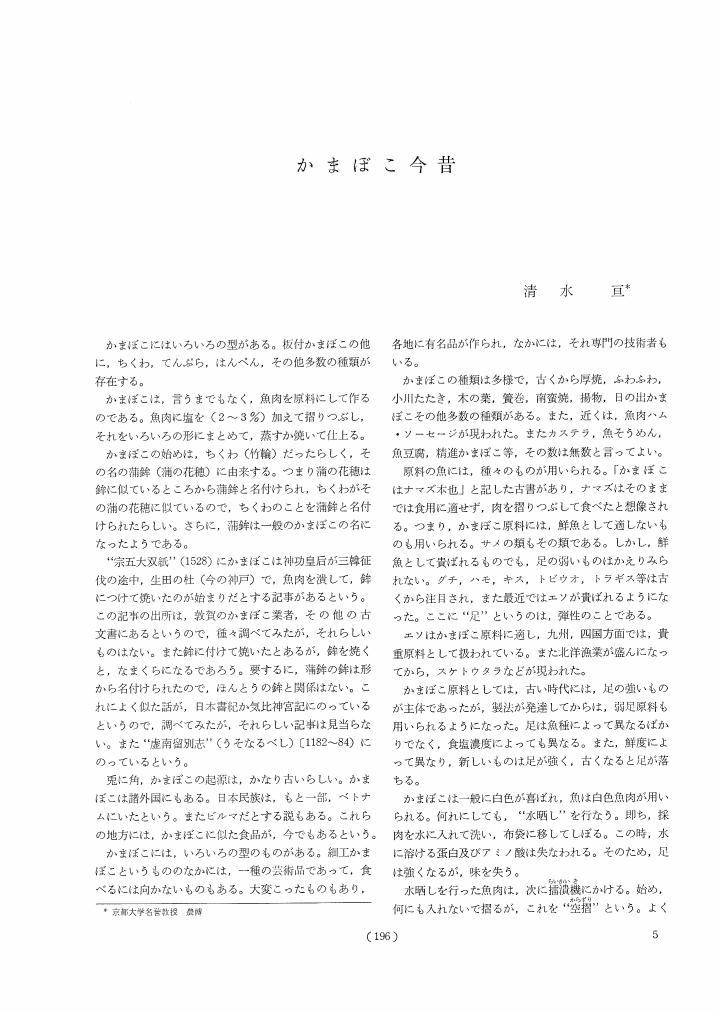1 0 0 0 OA かまぼこ今昔
- 著者
- 清水 亘
- 出版者
- 一般社団法人 日本調理科学会
- 雑誌
- 調理科学 (ISSN:09105360)
- 巻号頁・発行日
- vol.15, no.4, pp.196-199, 1982-12-20 (Released:2013-04-26)
1 0 0 0 OA くさやの研究-II くさや汁の細菌学的試験
- 著者
- 清水 潮 相磯 和嘉 清水 亘 望月 篤
- 出版者
- 公益社団法人 日本水産学会
- 雑誌
- 日本水産学会誌 (ISSN:00215392)
- 巻号頁・発行日
- vol.35, no.1, pp.109-115, 1969-01-25 (Released:2008-02-29)
- 参考文献数
- 4
- 被引用文献数
- 1
Microbiological examination of a curing brine of Kusaya showed that a species of halophilic corynebacteria which was given the name Corynebacterium kusaya predominated in the brine. A description of the species was given. An experiment with an artificial Kusaya brine suggested that the preserving effect of the Kusaya brine could be ascribed to the presence of this organism.
1 0 0 0 OA くさやの研究-I
- 著者
- 清水 亘 望月 篤 清水 潮 相磯 和嘉
- 出版者
- 公益社団法人 日本水産学会
- 雑誌
- 日本水産学会誌 (ISSN:00215392)
- 巻号頁・発行日
- vol.33, no.12, pp.1143-1146, 1967-12-25 (Released:2008-02-29)
- 参考文献数
- 2
Kusaya is a special salted-dried fish originated a few hundred years ago in the island of Niizima, off the south coast of Izu Peninsula, Japan. A peculiar feature of the product is long, successive use of its curing brine with occasional addition of concentrated salt solution: some of the brines are said to have been used for more than four hundred years. Although Kusaya (lit. smelt fish) has a strong, fermentation odour, its excellent taste has been much prized by consumers. The chemical analyses of a brine revealed that it contains less than 4% salt and 490mg% volatile basic nitrogen. The pH value of the brine was 7.80. In spite of the low salt concentration of the brine, filleted jackmackerel which had been dipped in the brine for 24 hours showed a marked delay in the development of volatile basic nitrogen during subsequent storage. A mild taste and good texture of the product owing to the low salt concentration would be responsible for the appraised quality of Kusaya. The possibility of the occurrence of special microorganisms which might contribute the preserving effect of the brine was discussed.
1 0 0 0 OA かまぼこの足について-XII
- 著者
- 志水 寛 吉本 晴樹 清水 亘
- 出版者
- 公益社団法人 日本水産学会
- 雑誌
- 日本水産学会誌 (ISSN:00215392)
- 巻号頁・発行日
- vol.28, no.6, pp.610-615, 1962-06-25 (Released:2008-02-29)
- 参考文献数
- 7
- 被引用文献数
- 3 4
A sticky paste, prepared by braying fish meat with 2 or 3% NaCl, turns to a tough and elastic gel, “kamaboko”, on cooking processes, such as steaming, boiling, or broiling. It has been experienced that if the processes are unsuccessfully conducted rather fragile gels sometimes yield. In the previous paper, the authors showed that in such cases the paste should be kept for a long time at a temperature range between 50°C and 60°C., the kamaboko gel lost its elasticity and became fragile. In the present study, such phenomenon, the collapse of gel structure during cooking, was observed. Samples used were lizard fish meat paste packed in Kurehalon tubus of diameter 3cm. (Kureha Kasei Co., Ltd.), and the cooking was made in water bathes kept at various temperatures. Gel-strength was evaluated by the magnitude of the tensile strength of a ring-shaped specimen (Fig. 1) and also the score values obtained by an organoleptic test in 10-point scale. Results are summarized as follows: (1) Lowering in the gel-strength during cooking occurred at higher temperatures than 50°C., favourably near at around 60°C. and again at 90°C. (Fig. 2). (2) Washing process on the raw chopped meat, by which a greater part of the water soluble matters was removed, raised the kamaboko-forming capacity of the meat paste, but had little effects on the change in gel-strength at 60°C. (Fig. 3). This may suggest that the water-soluble matters in the paste play a minor role in this phenomenon. (3) Meat pastes brayed of aged meat (stored for 5 days at 4°-5°C.) were more easily subjected to the heat influence at 60°C. than those of fresh meat (Fig. 3). (4) Initial pH of the paste seemed to have no significant influence on the occurrence of the phenomenon (Fig. 4). (5) Stability of the kamaboko gel to heating at 60°C. was quite different with the conditions, under which the paste had been kept prior to the cooking. Gels produced by pre-cooking at 80°C. and 90°C. for 20minutes did not change their strength even after heating for long time at 60°C., while those pre-cooked at lower temperatures than 70°C. were significantly damaged on the gel structure (Fig. 5).
